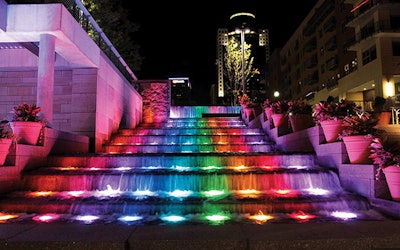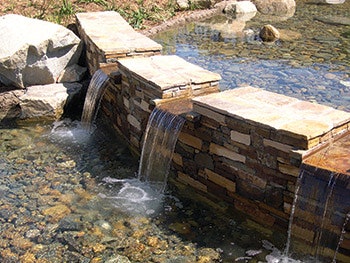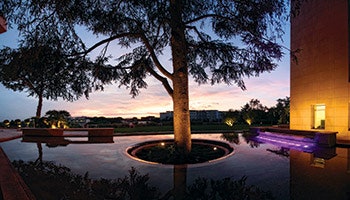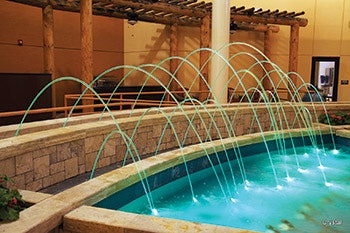




Toronto’s Crystal Fountains, today known simply as “Crystal,” has vast experience manufacturing fountain components and designing fountain systems. Here, Crystal’s director of special projects and creative direction designer, Robert Mikula, discusses the range of possible effects you can find in today’s water features and the importance of control and automation technology to manage them.
There’s a powerful kinship between fountains and swimming pools that goes far beyond the containment of water for the purpose of human enjoyment. That deeper connection stems from the fact that those who design and build fountains share the same challenge as those who work in pools in spas — we are ultimately all in the business of controlling the behavior of water by harnessing the characteristics of water.
In pools and spas, that challenge was once limited to the need to filter, chemically treat and recirculate a vessel’s contents. These days, however, pool builders are more and more likely to employ fountain effects in the form of water-in-transit systems such the vanishing edge, vertical plumes and jets, water walls, waterfalls, runnels, leaping jets and laminar flows among others.
Working effectively within this spectrum of fluid behaviors first requires understanding what you’re trying to achieve and then deploying today’s technologies, which make hitting the right notes far easier and more cost effective than in years past.
Put another way: The control and automation of fountains is all about unlocking the possibility of water as an art form.
DIVINING INTENT
In the broadest sense, nearly any man-made body of water is “controlled” or “automated,” at least since the advent of the Industrial Revolution. The technologies have changed and continue to do so, but the aim is very much the same today as it was when Islamic and Roman societies created public fountains, baths and reflecting pools.
When we talk about controlling and automating fountain effects in a modern context, the entire discussion begins with design intent, meaning what exactly you and the client want the system to do and the role waters play in the setting. Is the system there to create a destination, is it going to be interactive? Will it be architectural or choreographed, or function as a focal point within the landscape?
That basic premise encompasses a whole series of issues with respect to the site. How does the traffic flow in the space? Is it located indoors or outdoors? (The latter would make it subject to wind.) Will the structure be in an intimate location, or intended to be enjoyed in a large space by many at once? What’s an acceptable footprint for splash? (In many cases zero splash is the goal, especially within the public realm.)
If you don’t work with fountains on a regular basis, it can be surprising how many different types there are and the number of variables in play. Across this spectrum, one of the big goals of new technology is to expand the range of effects and their complexity while at the same time simplifying implementation within a budget.
JUST A FEW POSSIBILITIES…
All that said, understanding control and automation first means taking stock of the range of possible water effects. Going through the following brief list of the basic feature categories, keep in mind with each there are numerous variations. Each requires differing approaches to design, especially in how the water is controlled and, in many situations, automated.
Freeboard FountainsThe most basic and traditional is what we often call “freeboard” fountains. (These are also known as “skimmer pools,” a reference to vessels with pools of water from which water is drawn to feed bowl spillovers or simple jet effects.) These would include familiar courtyard fountains found in many residential settings as well as commercial and public spaces. Rome’s Trevi Fountains would an example of an extremely elaborate freeboard system, as would the fountains in London’s Trafalgar Square.
For many, freeboard fountains are what first come to mind when hearing the word “fountain.” In the past, these systems have been controlled in very similar fashion to a pool or spa, either with gravitational flows as used by the ancients, or, as is far more common in the modern era, with a simple on and off function with a timer-activated pump.
Today, even these simple fountains typically use far more sophisticated control technology for treatment, circulation and visual effects.
Water Walls
Because of the way they interface with built structures, many of us in the fountain business refer to water walls as “architectural” elements. As simple as they may seem, there are a variety of elements the come into play with water walls, including volume, the shape of the weir itself, the material and texture over which the water flows, lighting and even the sound the system makes.
Because they require precise water flows, the weirs should be built to specific tolerances and configurations — not unlike vanishing edges or perimeter overflows in pools. Water volume should be controlled by some type of valve or variable frequency drive pump and then evenly distributed across the edge, which requires even upwelling in the reservoir behind the weir.
More complex water walls have modular weir systems that can be rapidly actuated to create animated effects like surging. The texture of the water wall finishes also plays a role in water flow appearance. When you’re looking to avoid splash, the water flow should maintain contact with the surfaces over which it runs. Joints also become a significant consideration, as does the wall “batter” (a gradual backward slope in a wall); we generally want gravity to help us out. Splash mitigation techniques designed into the base of the waterwall are also important.
Generally, water walls are about containing the flow of water while making the water behave as envisioned. At times, that’s easier said than done.
Reflecting Pools Using the still surface of water for reflection has driven the design of some of history’s most iconic water features. (Think the pool in front of the Taj Mahal or the Lincoln Memorial Reflecting Pool in the National Mall in Washington, D.C.) In our work, reflecting pools can include vanishing edges, water tables and interactive flooded deck systems.
A big consideration with reflecting pools is the interior pool finish (or whatever the water is flowing over). The most effective reflecting pools typically use darker background colors. Darker finishes create the illusion of depth and create a superior reflective surface, unlike a light colored swimming pool, which draws the eye to the bottom of the pool.
Again, it may seem simple in concept, but ask any pool builder experienced in vanishing edge or perimeter overflow designs and they’ll surely acknowledge that a variety of factors come into play, including flow and dispersion over the edge, surge capacity, etc. And when those pools include leaping jet features, you find your way into today’s programmable sequencing technology.
Channels This category of features includes runnels, rills, canals and turbulent streams. Again, careful control of speed and volume can be critical. And as with water walls, understanding the way water interacts with the surface material and lighting elements is important.
Water Jets There are two primary types of traditional jets: the foaming jet and the streaming jet. Foaming jets are nozzles that are designed to add air to the outgoing flow of water. Streaming jets are designed to create more of a laminar or clear style of water flow.
Beyond those two basic types, there are many variations such as the fanning jet, cascade jet, burst jets, pod jets, crown jets & spray rings.
Sequenced Solutions This category includes more sophisticated jet and light technology that can be fully programmable on an individual level. Examples include the water switch (a prime example being Crystal’s Choreoswitch, one of our most widely used components) along with laminar/leaper arching jets, pop jets, fog/misting jets, articulating jets and the ultra-powerful/spectacular air-driven jet systems. These systems often include programmable LED lighting, music and multi-media considerations.
Interactive Features This dynamic category includes features designed for human interaction, such as those found in waterparks, community aquatic centers, public spaces and even in residential backyards. This category warrants its own separate discussion because of all the health and safety issues involved.
Magical Miscellany Beyond all the features types listed above, there’s the weird and wonderful world of custom effects development such as the vortex, the water void, bubble tubes, fire and water etc. These elements are typically considered custom and require further investigation via pool mock-ups.
IN CONTROL, DIGITALLY
Across this entire spectrum of effects, you’ll find control and automation tasks are managed digitally. (Budget and the various programming options come into play, of course.) Even if you consider the needs of even a simple fountain, you still have to control the circulation for filtration and chemical treatment and manage the jets or returns that supply the flow over weirs. Digital control has all but completely replaced old-school timers and relays.
In our work at Crystal, modern automation workhorse is known as the PLC (Programmable Logic Controller) device. It’s a small computer that handles incoming events in real time via inputs and outputs. Fountain control panels will typically have a PLC as part of the overall control system to activate pumps, control chemical treatment systems and send signals to sequencing devices.
VARYING THE FLOW
In a number of designs, there’s a need to vary or adjust the flow of water out of a jet, flowing over an edge or down a channel. Coupled with the PLC technology described above, fountain professionals have turned to variable frequency drive pump technology, just as pool designers and builders have.
VFDs allow for jets to be easily ramped up or down in programmed water sequences and also enable easy adjustment to flow rates for overflow pools, water tables, water walls, waterfalls, etc. (An important tool to help mitigate splash.) These devices also save on energy consumption by only using the energy required for a given operating scenario.
When you combine VFD pumps with digital controllers that can isolate individual jets and lights, there’s an almost infinite number of effect possibilities. Jets can be programmed to operate at different heights at different times, depending on the setting and situation. Waterfalls can be subtle as they’re ramped down to minimal flow, or robust with increased flow rates.
In this sense, when you talk about control and automation, VFD pumps have had the same kind of transforming impact in the world of fountains as they have in pools and spas.
WINDS OF CHANGE
Clearly, control of fountain effects is a wildly broad topic and one that changes depending on the all-important design intent mentioned above. One issue that anyone designing or building a fountain feature outdoors should consider is wind.
We typically include and program anemometers (or wind sensors) with a water feature design. This essentially dials the vertical jets up or down depending on the wind speed — a big factor in mitigating splash.
Finally, in many settings, it’s increasingly important to consider lower consumption water effects, like pop jets, so systems will use less energy and water while still resulting in impressive displays.
On the commercial side we are seeing a greater number of projects that include more “sustainable” and “green” requirements. Overall, the entire water feature industry is headed in that direction, as are many segments of the pool and spa industry.
In all cases, as stated at the start here, you have to understand what you want to achieve in order to develop and implement the appropriate level of control.
Comments or thoughts on this article? Please e-mail [email protected].











































